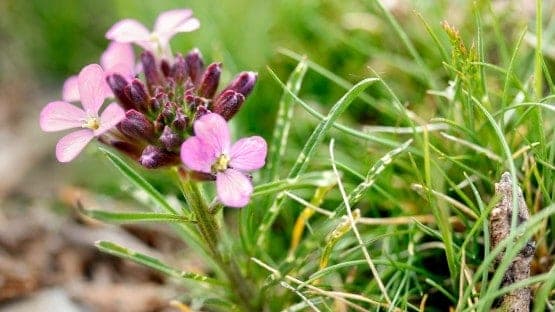Plant-derived chemicals called cardenolides have long been used to treat heart disease, and have shown potential as cancer therapies. But the compounds are very toxic, making it difficult for doctors to prescribe a dose that works without harming the patient.
For decades, researchers have tried to understand how plants biosynthesize cardenolides, knowledge that could help them discover and develop safer versions of the drugs. Unfortunately, the cardenolides’ best-known plant sources – foxglove and milkweed – are not suited for genetic studies.
In a study published April 7 in eLife, a multi-institution team co-led by Boyce Thompson Institute faculty member Georg Jander showed that Erysimum cheiranthoides (wormseed wallflower) could be used as a model species to elucidate that information. The team identified 95 candidate cardenolides, and has begun using the plant to investigate cardenolide biosynthesis.
Tobias Züst, a research associate at the University of Bern’s Institute of Plant Sciences, was corresponding author of the study, “Independent Evolution of Ancestral and Novel Defenses in a Genus of Toxic Plants (Erysimum, Brassicaceae).”
“Twelve different plant families produce cardenolides, but nobody knows exactly how they make them,” said Jander, also an adjunct professor at Cornell University’s School of Integrative Plant Science in the College of Agriculture and Life Sciences. “I was looking for the best plant to study this pathway and settled on wormseed wallflower.”
The species is a great model for genetic studies because it has a short life cycle and is readily inbred, he said. “We need a plant that reproduces and gives us seeds quickly, which E. cheiranthoides does in about 10 weeks.”
The team assembled the complete genome of the wormseed wallflower and sequenced more than 9,000 expressed genes from E. cheiranthoides and 47 other Erysimum species. The results provide a foundation for identifying the genes that encode enzymes involved in the biosynthesis of cardenolides. For example, the team discovered potential pathways by which Erysimum species modify a basic precursor cardenolide, digitoxigenin, into eight more structurally complex molecules.
To further enable the use of E. cheiranthoides as a model, the genome was assembled with techniques that can provide a more accurate genome than previous approaches, said co-author Susan Strickler, director of the BTI Computational Biology Center and senior research associate at BTI.
“A high-quality reference genome makes it easier for us to find genes of interest and their locations – in this case, genes for the biosynthesis of cardenolides,” she said.
The team is now conducting mutagenesis studies in E. cheiranthoides to allow them to find the entire cardenolide biosynthetic pathway. “Ultimately the genes underlying the biosynthetic pathways could be inserted into bacteria or yeast, which would be used to manufacture heart and cancer medicines that are safer than those currently available,” said Jander.
The study was supported by funding from the National Science Foundation, the Swiss National Science Foundation and a grant from the Ithaca-based Triad Foundation, which funds early work in new areas of research.
Other BTI co-authors on the paper are faculty member Lukas Mueller, who is also an adjunct professor at Cornell University’s School of Integrative Plant Science in the College of Agriculture and Life Sciences; Adrian Powell, research associate in the Mueller lab and member of BCBC; Mahdieh Mirzaei, a former visiting scientist in the Jander lab; Thomas Fisher-York, a bioinformatics analyst in the Mueller lab; and Cynthia Holland and Pavan Kumar, former postdoctoral scholars in the Jander lab.

